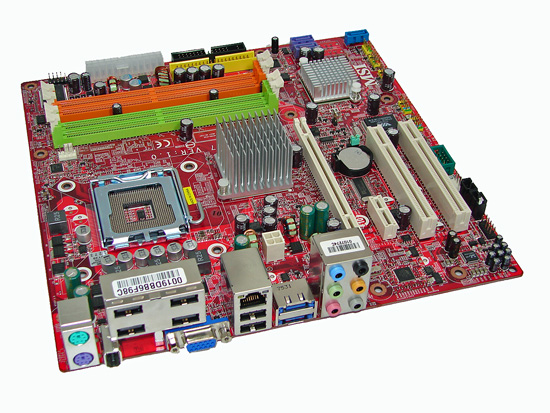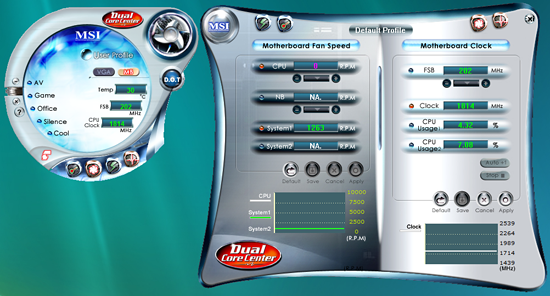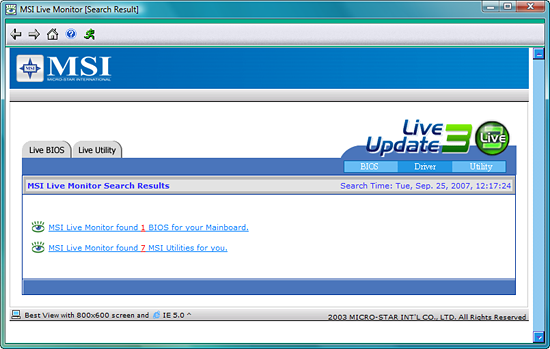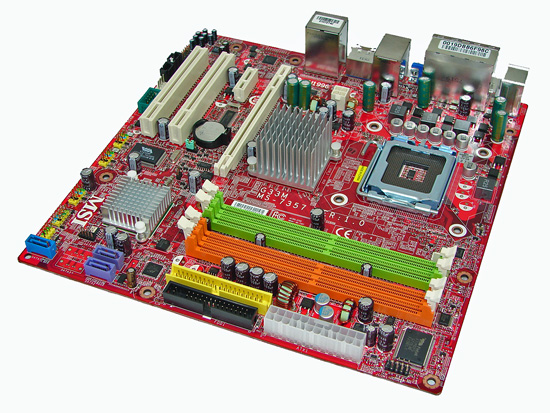µATX Part 2: Intel G33 Performance Review
by Gary Key on September 27, 2007 3:00 AM EST- Posted in
- Motherboards
MSI G33M: Board Layout and Features

MSI includes most of the same features as Gigabyte and ASUS, but the location of some of these features is different. The color scheme is also different, coming in MSI's typical red PCB with a few colorful additions. MSI does save a bit of money by using standard electrolyte capacitors in some areas rather than 100% "solid" conductive polymer aluminum capacitors. We really don't have a problem with this approach, as none of the three boards we're looking at today really target the high-end market.
MSI's rear panel is definitely unique in terms of layout, with four of the USB ports coming on a block that sits above the VGA and Firewire ports. MSI also offers two eSATA ports, at the cost of providing two internal SATA connectors. They use a Marvell chip to power the IDE port as well as an additional SATA port. The remainder of the rear panel consists of the typical PS/2, Firewire, network, and audio connections.
The location and layout of the connectors is generally fine, but the ATX12V is located below the CPU socket, and in most cases it will require looping the cable above the CPU heatsink which is less than ideal. You can also see the blank area on the bottom of the board where two additional SATA ports could have been installed. A single eSATA port would have been sufficient, we think, but perhaps there are people out there that make more use of eSATA than us.
One final concern worth pointing out on the MSI design is that the DIMM slots are not properly color coordinated, at least not relative to the rest of the industry. We generally feel that users like to install DIMMs into the same colored slots for dual channel operation, but MSI chooses to color channel A orange and channel B green. This makes it a lot more difficult to explain which slots should be used for dual channel operation, as you actually have to use the first orange and the first green slot (or the second slots on both channels) to get dual channel memory support. It seems like it would be a lot easier to simply say "install memory into the same colored slots" -- and considering the rest of the industry has taken that approach, we feel MSI should join the club.
MSI chose to include a PCI-E x1 slot in place of the x4 slots on the Gigabyte and ASUS boards, and they have the slot located next to the main x16 connector. That means if users happen to install a dual slot GPU they will not have access to any other PCI-E slots. Whether or not that's a serious problem is up to the individual to decide, but PCI ports are becoming less and less used as time goes on so long term this may not be the best design decision. Clearance between the PEG slot in the memory clips continues to be very tight, and use of a smaller graphics card might be advisable on all three of these motherboards. Anyone looking at an HTPC setup would probably use one of the fanless GeForce 8500/8600 or Radeon 2400/2600 cards, but gamers might find it difficult to install a GeForce 8800 or Radeon HD 2900.
Both chipsets are passively cooled, just like the other two boards. That's a really good design decision for anyone looking at creating a silent HTPC, but then we have to return to the video output options and end up scratching our heads. If it isn't clear yet, we really aren't all that impressed with the G33 chipset. MSI also includes two fan headers, both 4-pin: one for the CPU and one for the chassis. The chassis connector is located at the very bottom, just below the last PCI slot. Fan speeds for both connectors can be individually controlled within the BIOS or via software.


Naturally, MSI also includes a set of software utilities. Other than the MSI Live Monitor, these utilities of course have to have unique appearances with funky shaped windows and odd button locations. Call us old-fashioned, but we really don't have a problem with rectangular application windows that follow the standard Windows look and feel.

MSI includes most of the same features as Gigabyte and ASUS, but the location of some of these features is different. The color scheme is also different, coming in MSI's typical red PCB with a few colorful additions. MSI does save a bit of money by using standard electrolyte capacitors in some areas rather than 100% "solid" conductive polymer aluminum capacitors. We really don't have a problem with this approach, as none of the three boards we're looking at today really target the high-end market.
MSI's rear panel is definitely unique in terms of layout, with four of the USB ports coming on a block that sits above the VGA and Firewire ports. MSI also offers two eSATA ports, at the cost of providing two internal SATA connectors. They use a Marvell chip to power the IDE port as well as an additional SATA port. The remainder of the rear panel consists of the typical PS/2, Firewire, network, and audio connections.
The location and layout of the connectors is generally fine, but the ATX12V is located below the CPU socket, and in most cases it will require looping the cable above the CPU heatsink which is less than ideal. You can also see the blank area on the bottom of the board where two additional SATA ports could have been installed. A single eSATA port would have been sufficient, we think, but perhaps there are people out there that make more use of eSATA than us.
One final concern worth pointing out on the MSI design is that the DIMM slots are not properly color coordinated, at least not relative to the rest of the industry. We generally feel that users like to install DIMMs into the same colored slots for dual channel operation, but MSI chooses to color channel A orange and channel B green. This makes it a lot more difficult to explain which slots should be used for dual channel operation, as you actually have to use the first orange and the first green slot (or the second slots on both channels) to get dual channel memory support. It seems like it would be a lot easier to simply say "install memory into the same colored slots" -- and considering the rest of the industry has taken that approach, we feel MSI should join the club.
 |
| Click to enlarge |
MSI chose to include a PCI-E x1 slot in place of the x4 slots on the Gigabyte and ASUS boards, and they have the slot located next to the main x16 connector. That means if users happen to install a dual slot GPU they will not have access to any other PCI-E slots. Whether or not that's a serious problem is up to the individual to decide, but PCI ports are becoming less and less used as time goes on so long term this may not be the best design decision. Clearance between the PEG slot in the memory clips continues to be very tight, and use of a smaller graphics card might be advisable on all three of these motherboards. Anyone looking at an HTPC setup would probably use one of the fanless GeForce 8500/8600 or Radeon 2400/2600 cards, but gamers might find it difficult to install a GeForce 8800 or Radeon HD 2900.
Both chipsets are passively cooled, just like the other two boards. That's a really good design decision for anyone looking at creating a silent HTPC, but then we have to return to the video output options and end up scratching our heads. If it isn't clear yet, we really aren't all that impressed with the G33 chipset. MSI also includes two fan headers, both 4-pin: one for the CPU and one for the chassis. The chassis connector is located at the very bottom, just below the last PCI slot. Fan speeds for both connectors can be individually controlled within the BIOS or via software.


Naturally, MSI also includes a set of software utilities. Other than the MSI Live Monitor, these utilities of course have to have unique appearances with funky shaped windows and odd button locations. Call us old-fashioned, but we really don't have a problem with rectangular application windows that follow the standard Windows look and feel.










26 Comments
View All Comments
strikeback03 - Friday, September 28, 2007 - link
When building a couple computers for work using the MSI P35 Platinum board, it appears they don't support eSATA hot-swapping, at least not in XP. I know my Foxconn G965 board at home can do it. Is this behavior still present in the MSI board here? Is it a P35 limitation, or BIOS, or what?hans007 - Friday, September 28, 2007 - link
I dont get it...an svdo card (add2-n) with dvi output costs what $6 on ebay. why dont you guys just buy one, so you can test these with digital.
also the video driver in vista 32bit is not as mature still as the recently released gma 3000 compatible XP driver.
most people actually have XP so could another round of benchmarks in XP be run? I probably wont even get vista for at leas tanother year, since well its pointless and has no reason for being bought at this point.
lopri - Saturday, September 29, 2007 - link
Well.. it seems like you're using Windows XP and a monitor via VGA. Then why bother with these new IGP-based mATX boards? 915G/945G (or GeForce 6100) series would be a better choice for you. They are a lot cheaper (~$50 probably) and XP support is as mature as can be.In the center of this new wave of IGPs is the advent of HD contents. Vista is kinda necessary-evil in a sense but in general it handles HD and multimedia contents a lot better than XP and has a more intuitive/prettier UI for a living room environment. CRT has long been dead in living rooms, and if you prefer CRT over LCD for some reason (professional gaming maybe?) IGP wouldn't be an option to begin with.
I'd say DVI is the minimum requirement, HDMI w/HDCP being a preferred solution in these days and nights.
veritronx - Thursday, September 27, 2007 - link
One thing that may have been overlooked.. The MSI board is the only one suitable for people looking to use a dual-slot graphics card as well as, say, a creative sound card, with some space between them. For that reason the only board reviewed that I would look at buying would be the MSI.Ajax9000 - Thursday, September 27, 2007 - link
From page 1:Read the following Nvidia pages and the news is somewhat disappointing re HD video.
Summary PDF -- http://www.nvidia.com/object/IO_35712.html">http://www.nvidia.com/object/IO_35712.html
AMD (MCP78) features -- http://www.nvidia.com/object/mobo_gpu_features_ben...">http://www.nvidia.com/object/mobo_gpu_features_ben...
AMD (MCP78) specs -- http://www.nvidia.com/object/mobo_gpu_tech_specs.h...">http://www.nvidia.com/object/mobo_gpu_tech_specs.h...
Intel (MCP73) features -- http://www.nvidia.com/object/mcp_features_benefits...">http://www.nvidia.com/object/mcp_features_benefits...
Intel (MCP73) specs -- http://www.nvidia.com/object/mcp_intel_techspecs.h...">http://www.nvidia.com/object/mcp_intel_techspecs.h...
PureVideo is only listed for the MCP78 (7050PV+630a) combination. All the other AMD chipsets and none of the Intel chipsets have PureVideo HD.
If, in the future, they release an MCP73 using (say) 7050PV+630i then memory will be limited to DDR667.
There is no details thus far, but what would be good is if the new chipset fixes the HD Audio problem that all current HDMI video cards seem to suffer from (i.e. the problem whereby the chipset supports HD Audio, but the video cards can only accept SPDIF-grade audio for HDMI pass-through).
BansheeX - Thursday, September 27, 2007 - link
Everyone who is letting these boards have it for not including HDMI/DVI is completely right. It makes no sense. Sure, I could buy a cheap DVI graphics card and stick in there, but if I have to do that, why would I buy a board with onboard graphics in the first place?Sadly missing from this review is the board that DOES include onboard DVI, Intel's own DG33TL. Even sadder is that it takes Intel to make the feature-full board while the OEM companies go for the minimum.
Emma - Thursday, September 27, 2007 - link
I agree with the others, as most computers I build have IGP's, being able to directly compare each of the available IGP's on the market would be about the best thing from a review for a long time.The 6100/6150SE should also be included as this is still widely sold.
Also of interest would be a summary of what other nVidia and AMD IGP's are on the horizon.
Thanks!
Owls - Thursday, September 27, 2007 - link
"We generally feel that users like to install games into the same colored slots for dual channel operation, but MSI chooses to color channel A orange and channel B green."I wasn't aware you could install games into DIMM slots.
JarredWalton - Thursday, September 27, 2007 - link
Sorry 'bout that - I was helping Gary out a bit and managed to mangle the text. Blame the speech recognition. That or I'm just slurring my words a bit. :)8steve8 - Thursday, September 27, 2007 - link
great article tackling most the issues that we care about!question #1: why bother reviewing boards without DVI or HDMI?
whether we are building pc's for friends/offices etc, or an office/server box for ourselves, or we want it to find a home in its post-gaming life when we ditch it for something better... DVI will be key. inexcusable that they pinch pennies there and frankly not worth your time considering these boards. gigabyte has a g33 board with dvi/hdmi, as does intel...
http://www.newegg.com/Product/Product.aspx?Item=N8...">http://www.newegg.com/Product/Product.aspx?Item=N8...
http://www.newegg.com/Product/Product.aspx?Item=N8...">http://www.newegg.com/Product/Product.aspx?Item=N8...
question #2: this would have been muuuch more useful like 5 months ago when G33 was new. now it's about to be eclipsed by the 7150 and g35.
overall i cant wait to see a similar roundup with modern chipsets like g35/nvidia 7150/ g690 and 7050pv for amd...
would be interesting to see a cost/perf of integrated platforms including cpu costs...
mobo + cpu costs... it seems amd has some good cheap 690g boards out there, with dvi/hdmi for around $75. (almost $50 cheaper than a g33 board with dvi)...